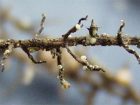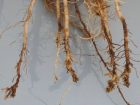
Features
Agronomy
Insect Pests
Exploring management strategies for nematode species in Ontario
Plant-parasitic nematodes are hidden yield robbers. But research and monitoring efforts are helping to uncover their secrets. Plant pathologist Albert Tenuta conducted a survey of soil-dwelling nematode species in Ontario crops and his ongoing collaborative research looks to improve management strategies for these microscopic, worm-like pests.
December 18, 2017 By Carolyn King
 Soybean cyst nematode is the number one yield-limiting soybean disease in Ontario in most years. Photo courtesy of Albert Tenuta, OMAFRA. Plant-parasitic nematodes are hidden yield robbers.
Soybean cyst nematode is the number one yield-limiting soybean disease in Ontario in most years. Photo courtesy of Albert Tenuta, OMAFRA. Plant-parasitic nematodes are hidden yield robbers.Tenuta explains that many different nematode pest species are in Ontario crop fields, and usually several species coexist within a field. Each species has its own particular habitat and host plant preferences. They feed on plant roots, stealing nutrients from the plant. As well, the damage from feeding can provide entry points for other root pathogens.
“The first challenge with managing nematodes is general awareness. In many cases, growers, agricultural consultants and others don’t think of nematodes first or may not even think of them at all as a potential cause of the problems they see in a field,” notes Tenuta, who is with the Ontario Ministry of Agriculture, Food and Rural Affairs (OMAFRA).
“If you’re a soybean grower in the southern part of the province, particularly the southwest, soybean cyst nematode should be on your radar because it is a serious issue that has been around for a while. But every year I find new infestations and growers aren’t even aware of the problem,” he says.
“The other challenge is that nematode impacts are easy to misdiagnose. Many of the symptoms mimic other common problems, such as drought, insect injury, herbicide injury, compaction, pH issues, or fertility issues.”
The exact symptoms depend on the nematode species and the crop type. Typical aboveground symptoms include patches of yellowed, wilted or stunted plants. Root symptoms may include things like lesions, swellings and discolouration. In the case of soybean cyst nematode, the roots have tiny, lemon-shaped cysts. These cysts, which hold the nematode’s eggs, change from white, to yellow, to brown over time.
Tenuta has been involved in a range of nematode studies over the years. Most recently, he completed a three-year project (2014 to 2017) on soybean and corn nematodes. Grain Farmers of Ontario funded the project, including Tenuta’s participation in collaborative research with researchers from the United States, whose activities are funded under the U.S. North Central Soybean Research Program.
Survey highlight
One of the project’s objectives was to survey nematode species and their population levels across Ontario, mainly in corn and soybean fields. The patterns seen in this latest survey continue the trends revealed in previous nematode surveys that Tenuta has worked on.
The two most important nematodes in Ontario are still soybean cyst nematode and root-lesion nematode.
“In soybeans and dry beans, soybean cyst nematode is the number one nematode issue in terms of yield loss potential. And for soybeans, this nematode is the number one yield-limiting soybean disease across the province in most years,” Tenuta says.
He notes that soybean cyst nematode has a very narrow host range. “Just a few legume species are hosts. In Ontario, soybeans and dry beans are the most common hosts, and some cover crops may be susceptible.”
Soybean cyst nematode (Heterodera glycines) is not native to Ontario; it was first found in 1988 in the Chatham area and has since spread. Tenuta says, “[The latest survey shows] soybean cyst nematode is continuing to spread across Ontario and to increase in numbers in certain parts of the province, such as the southwest. We are seeing more of it in eastern and central Ontario, and those populations are starting to build up. This species tends to first be found in sandy soils, but it can also occur in heavier soil textures.”
Root-lesion nematode (Pratylenchus species) is a widespread group that includes multiple species. “Root-lesion nematode is the one type that we have across the province in basically all soil types and regions and at levels that are high enough to be a major concern,” he notes. “Its broad host range not only encompasses corn, soybeans and wheat, but also horticultural crops, multiple weed species, ornamentals, etcetera.”
According to Tenuta, root-lesion nematode seems to be an increasing problem in the province. “In about 25 per cent of the fields we surveyed, the root-lesion nematode numbers were at or near what we consider to be the threshold [the level that would justify control measures], which is very similar to the levels seen in the U.S. Midwest.”
He suggests a couple of possible reasons for this nematode’s increase. “One reason could be a reduction that we have seen in the use of some of the in-furrow or seed treatment insecticides. Those products might have had helped suppress some nematode populations in the past,” he explains.
“In addition, we don’t have a handle on the genetic tolerance or resistance to root-lesion nematode in different varieties of corn, soybeans, wheat and other crops. With soybean cyst nematode, we have some very good resistance genes, some very good [varietal] data and ongoing breeding efforts. But we generally don’t have the same types of efforts for other nematodes. That is important to consider in the future for private and public breeding programs.”
As expected, the survey found various other nematode species. “You will often find other nematodes such as the spiral nematode [Helicotylenchus species] and pin nematode [Paratylenchus species]. Most of those are at background levels. It’s rare that we would see populations of these other nematodes creep up and cause an issue under Ontario conditions.”
For example, one nice finding from the survey was that some of the nematode types causing serious issues in the U.S. Midwest, like the needle nematode (Longidorus species), are not causing problems in Ontario. He notes, “The needle nematode is the most devastating type of corn nematode in the U.S. Midwest.”
Rotation effects
Tenuta’s project also included a component about the impacts on nematode populations of various crop rotations, focusing on cover crop effects. This is an ongoing study.
“Crop rotation needs to be one of the tools in the IPM [integrated pest management] toolbox for producers. For soybean cyst nematode, crop rotation definitely helps, although it will not eliminate the nematode,” he notes. “But with root-lesion nematode’s wide host range, don’t expect to see a reduction in its population with just crop rotation.”
It’s too early in this study to draw conclusions about the effects of specific cover crops on nematode populations. But Tenuta offers some general advice, “Remember that cover crops have the potential to be hosts to beneficial organisms as well as pests. We are trying to get a better handle on that. For instance, we have indications that some cover crops may increase nematode populations.
“A great example is sunn hemp [a fast-growing legume]. It has been promoted as a way to reduce nematodes including soybean cyst nematode, and we did not see soybean cyst nematode reproduction on sunn hemp. But, among the cover crops in the study, sunn hemp had by far the most root-lesion nematodes associated with its roots. That suggests sunn hemp would be a very big concern when it comes to root-lesion nematode.”
Nematicide testing
Another component of the project is part of an ongoing collaboration to assess various nematicide seed treatments for corn and soybeans. Tenuta is evaluating how the seed treatments perform under Ontario growing conditions and management systems.
“Some of the products in the trials are available right now in Ontario; we’ve got Clariva [active ingredient Pasteuria nishizawae] and Votivo [Bacillus firmus]. Because we are collaborating with the U.S. universities involved in the North Central Soybean Research Program, we have also been looking at products registered in the U.S. but not yet registered in Canada, as well as products that are getting close to being registered in the U.S. or Canada. So you will probably start to see three or four new nematicide seed treatments start to come to market here in the next two to five years.”
Tenuta emphasizes, “These seed treatments are not a silver bullet. They will not eliminate nematodes from a field, and their effectiveness may be greatly impacted by field variability, nematode population levels, environment, and so on. However, they may help reduce the reproduction of nematodes in a given year. And they may slow increases in new populations like the soybean cyst nematode HG types [Heterodera glycines variants] that have overcome the resistance genes in our resistant soybean varieties. So these nematicides can be an important addition to our IPM toolbox.”
In these trials, the biggest impact from the nematicides occurred when the products were used in conjunction with a soybean cyst nematode-resistant variety. “The seed treatment was able to build onto that resistance package, increasing the effectiveness,” he explains.
“On the susceptible varieties, we could see a response to the nematicides, but in many cases, the fields where we were testing had moderate to high soybean cyst nematode populations. And with high nematode pressures and a susceptible variety, it is very difficult for a seed treatment to do a full job.”
He adds, “Whenever it comes to disease management, the ideal approach is to start with genetic resistance, and build from there with other IPM tools.”
For information on using the currently registered nematicide products, see OMAFRA’s Field Crop Protection Guide.
Tenuta’s tips
A crucial step in dealing with nematodes is to get them on your checklist of possible problems. “When you scout your crop, go with an open mind and look at all the factors. Nematodes are one of those factors,” Tenuta says.
“We need to start thinking about those fields or areas within fields that have chronic problems. Once you have ruled out the typical causes of those problems such as fertility and soil issues, then those areas are prime locations for nematode testing.”
Sending soil and root samples to a nematode-testing lab is the most reliable way to diagnose a nematode problem. You need to test both the roots and the soil because some species live inside plant roots for most of their lives, while other species live in the soil and feed on the outer parts of the root. Contact your lab for proper sampling and handling procedures.
Tenuta notes that these lab tests will identify the nematode species in the samples, which can be important for crop rotation decisions since different nematode species prefer different hosts.
If you’re considering a nematicide seed treatment, you may want to begin with a strip trial to check its effectiveness under your field’s specific conditions. For managing soybean cyst nematode, growing resistant soybean varieties is a key practice, and crop rotations with non-hosts will provide additional help.

